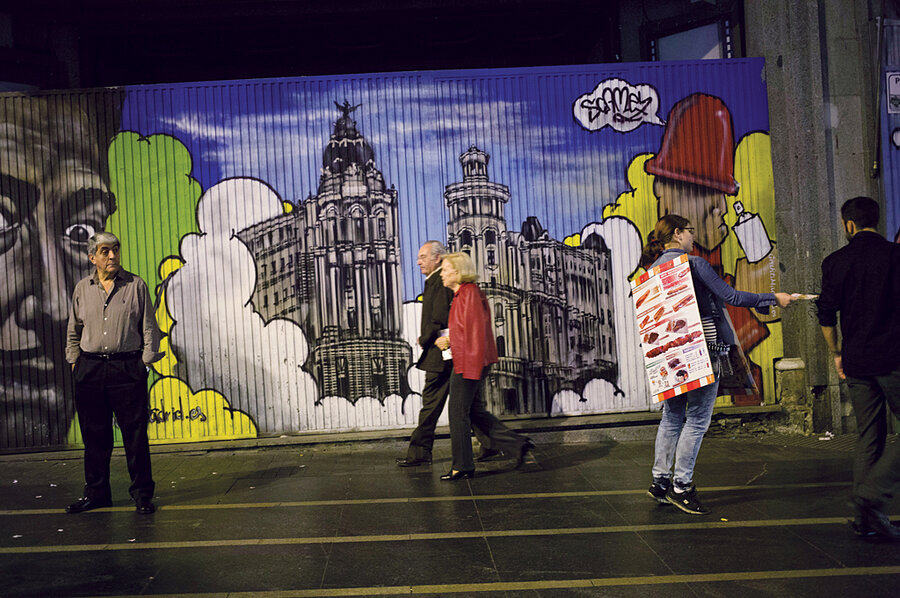With no jobs in the city, country life is coming back to Spain
Loading...
| Rioseco de Soria and Zuzones, Spain
Things couldn't have looked bleaker back in 2008 for Guillermo Umberto Domínguez.
A construction worker originally from Ecuador, he was unemployed and struggling to survive in what was the beginning of Spain's grueling economic crisis. His wife, a Spaniard, was pregnant, but he only had €400 ($520) a month left over after paying rent. He needed a job, a very low cost of living, and a nearby school for his children.
Today, Mr. Domínguez and his family are comfortably ensconced in the tiny village of Rioseco de Soria, which is located about 100 miles north of Madrid and has fewer than 100 regular inhabitants. Rioseco is about 10 minutes away from a highway, across breathtaking, but rough, lonely, and cold Castilian ochre flatlands perched in the mountains. The scenery is dotted by crumbling towers and castles and forest patches surrounded by farmland.
Between the cheap rent that the municipality offered and the private construction job he was offered, Domínguez now nets as much as €1,000 ($1,300) a month. His children, a small child and a teenager from his previous marriage in Ecuador, are enrolled in local schools.
And most important for Rioseco, the Domínguez family's presence is helping the village stop its steady population drain.
In what could be one of the few silver linings of the economic crisis gripping Spain and the European periphery, the ongoing economic pain has slowed a decades-long flow of rural dwellers to the cities, experts say, and has made country life more viable. While many are still leaving, increasingly others are also coming – and in many cases returning – to the countryside, whether to retire, as a weekend destination, or as a cost-cutting solution for professionals who work in cities.
"The same number of people that are leaving are arriving. Rural life is recovering because the newcomers are in effect neutralizing the effect of a rapidly aging population," says Benjamín García Sanz, a rural sociology expert at the Universidad Complutense de Madrid. "That is, they are not increasing the population, but replacing it. And that is a huge achievement."
Population trends
Spain has been losing rural population for decades, an old problem that deeply affects all European countries.
As industrialization took hold across the Continent, Europe saw its rural dwellers pull up roots to find new opportunities within the cities, draining the countryside of its residents. Northern European countries like Britain and Germany lost their core rural population long ago, while the so-called urban exodus came later to southern European countries, in conjunction with their delayed industrialization. In Spain, industrialization took hold after its civil war, which ended in 1939. By 2000, Spain had shed most of its rural population.
But while their populations have dwindled, rural territories still make up a majority of the European Union and play a corresponding role in the EU economy.
Rural regions cover 57 percent of the EU and hold 24 percent of its population. When including "semirural" areas adjacent to cities, the coverage increases to 91 percent with 59 percent of the population. Rural and intermediate regions account for almost half of the economy, and supply more than half the jobs in the EU, according to the latest EU Commission report on rural development, published in December 2012.
Reversing the flow
As such, Europe for decades has implemented policies to buoy rural development. Initially, most of the efforts were directed at supporting agriculture; but with the new century, policies have increasingly moved to boost alternative economic development, especially in semirural areas.
France is at the forefront of policy efforts to support rural life, followed by Italy and Spain. Ireland and Spain stand out for their raw rural population increase over the past decade, although net migration to rural and intermediate areas has consistently increased in Western Europe, while decreasing in Eastern Europe. The share of children under age 15 continues to decrease, while the share of people over 65 is stabilizing.
Although "rural life will never be what it used to be," Dr. García says, net population growth is no longer plunging, and in some places it has stabilized or even started growing.
In all, Europe committed nearly €100 billion ($130 billion) from local, country, and EU resources to rural development through a five-year program ending in 2013, 18 percent of which goes to nonagricultural and quality-of-life rural development, from tourism and infrastructure to high-speed Internet, training, and repopulation.
"It is these more targeted schemes which are vital for boosting new opportunities in rural areas, not only in agriculture," says Roger Waite, EU Commission spokesman for Agriculture and Rural Development.
A silver lining in the economic crisis?
But if European policies began to reverse the flow of urban immigration, Europe's economic crisis – which hit Spain when the real estate bubble burst in 2008 – kicked the reversal into overdrive.
The crisis has been devastating to Spain, both in the cities and in the countryside. The Spanish economy remains in recession. The International Monetary Fund forecast in mid-April that Spain's economy would contract a further 1.6 percent in 2013 and only grow 0.7 percent in 2014. Unemployment, rapidly approaching 27 percent, is expected to remain above 25 percent for years. Almost a quarter of Spaniards are below the poverty line, with an annual income of less than €7,300 ($9,500). More than a million families are without any source of income.
But rural economies were less exposed to the economic crisis, and thus the impact of the housing bubble's bursting has been blunted. Years of policy-driven initiatives and investments to improve services are also paying off now that the economic downturn has made country life more appealing, even if its appeal is ultimately driven by a lack of alternatives.
"The crisis intensifies these trends," says García, who in 2011 published the results of a comprehensive study on emerging rural trends and their challenges. "People return to towns because the cost of living is cheaper and there are no jobs in the cities. The number of people wanting to come to towns is increasing, even if in net terms the numbers are marginal."
And while the situation is far from rosy, those living in population centers with fewer than 100 people increased nearly 13 percent over the past 10 years in Spain and decreased only slightly in population centers with fewer than 5,000. More people have relocated from cities to towns in the past 15 years than the other way around.
The numbers, assembled by Spain's official census agency, are incomplete because the Spanish Census, like the US Census, only takes official residences into account. That means people with two homes – often one in the city and one in a more rural area – are not fully counted. But regardless, García says, the crisis is surely working mostly in favor of rural-region populations.
And the trend is not confined to Spain. The countries hit hardest by the crisis are witnessing an increased flow from cities to the countryside, especially in Greece and Portugal. Employment in rural areas started increasing in 2011 predominantly in the nonagricultural sector, according to the EU Commission, and preliminary studies suggest the trend continued in 2012.
Careful growth
European-funded programs, channeled through so-called LEADER projects, are a lifeline for both towns and people, Rioseco and Domínguez, for example. It's a bottom-up approach in which local communities become involved in their own development, meeting crucial goals with very little expenditure.
Rioseco, for example, identified its need for more housing to accommodate new families. So it renovated the old residences for the doctor and teacher, abandoned years before, with the help of local, Spanish, and European funds.
The funds bring work, but more important, they bring people. The village determined that it would only rent to those who met specific criteria: people who could fill its limited job vacancies – one of them for a construction worker like Domínguez – and who had children to attend its school. Without enough students, schools are shut down, and without schools, towns are condemned to slowly disappear.
But in Domínguez – one of three people who moved to the village with their families – Rioseco found an excellent fit. He is very happy, and Rioseco is able to keep its school thanks to families like his who were attracted by low costs. And the multiplier effect means that the town, and those that surround it, are now all benefiting from its resurgence.
The result is positive for rural life, even if it's hard to measure. Both public and private efforts to jump-start rural life are more attractive now.
"Ten years ago, being from a town had negative connotations, but the paradigm has changed since and now it's positive to be rooted to a town," García says.
A long road
Success is not guaranteed, either for Rioseco or for rural entrepreneurial efforts like La Estación. The balance is fragile and obstacles are numerous. But projects like these are ultimately the best chance of survival for Europe's rural areas.
Internet forums are riddled with messages of desperate families and jobless youths in cities seeking any job, any place, and just about under any circumstances. These individuals are precisely the kind of newcomers that communities don't want because they carry a high risk of desertion. Dozens of upstart, utopian ideas of repopulating never get off the ground because often people offer their labor, not capital.
Numerous associations are also trying to filter through all that desperation to support more sustainable efforts and to bring together people more apt to make a long-term commitment to communities and projects starving for them.
Domínguez and his family have no plans to leave. They live a safe and secure life, and the kids are getting a good education, some of it in English because Rioseco was able to get funding for a part-time bilingual teacher, a privilege for many in Spain.
"I have tons of friends who would come immediately if there was a job here and cheap housing," he says. But there is none.
Soon Rioseco will have to find new families because children are moving on to high school. There's no plan yet, and it will likely depend on available jobs. At least for now, residents have managed to repopulate and rejuvenate their town, to survive.
Country life gets lonely and can be a hornet's nest as Rioseco's residents can affirm.
"But we love it here," Domínguez says. "The crisis isn't over, but as a father I prefer to spend it here than in a city."









